BoreDoc supports you in professionally documenting drillings and maintaining an overview at all times. From recording the strata to the complete drilling log, BoreDoc bundles all important information in one place. This turns complex data into clear structures that are convincing both in everyday life on the construction site and when working with clients, authorities or partners.
BoreDoc is a cross-platform app for structured drilling documentation. It replaces handwritten forms and reduces errors through guided, structured input. Different project types such as soil sampling, exploratory drilling or well construction are supported - including the simple creation of layer directories, drilling profiles and other documents.
In contrast to traditional applications, BoreDoc works flexibly as an app and web application. Multiple users can work with the current database at the same time - regardless of end device or operating system. Integrated multilingualism makes collaboration even easier: if an English-speaking user enters "Clay", a German-speaking user automatically sees "Ton". Language settings in the user interface and in the documents can be freely selected.
BoreDoc thus optimises teamwork - in a structured, efficient and even cross-language manner. Whether for engineering offices, construction companies or experts: BoreDoc makes drilling documentation efficient, transparent and reliable.
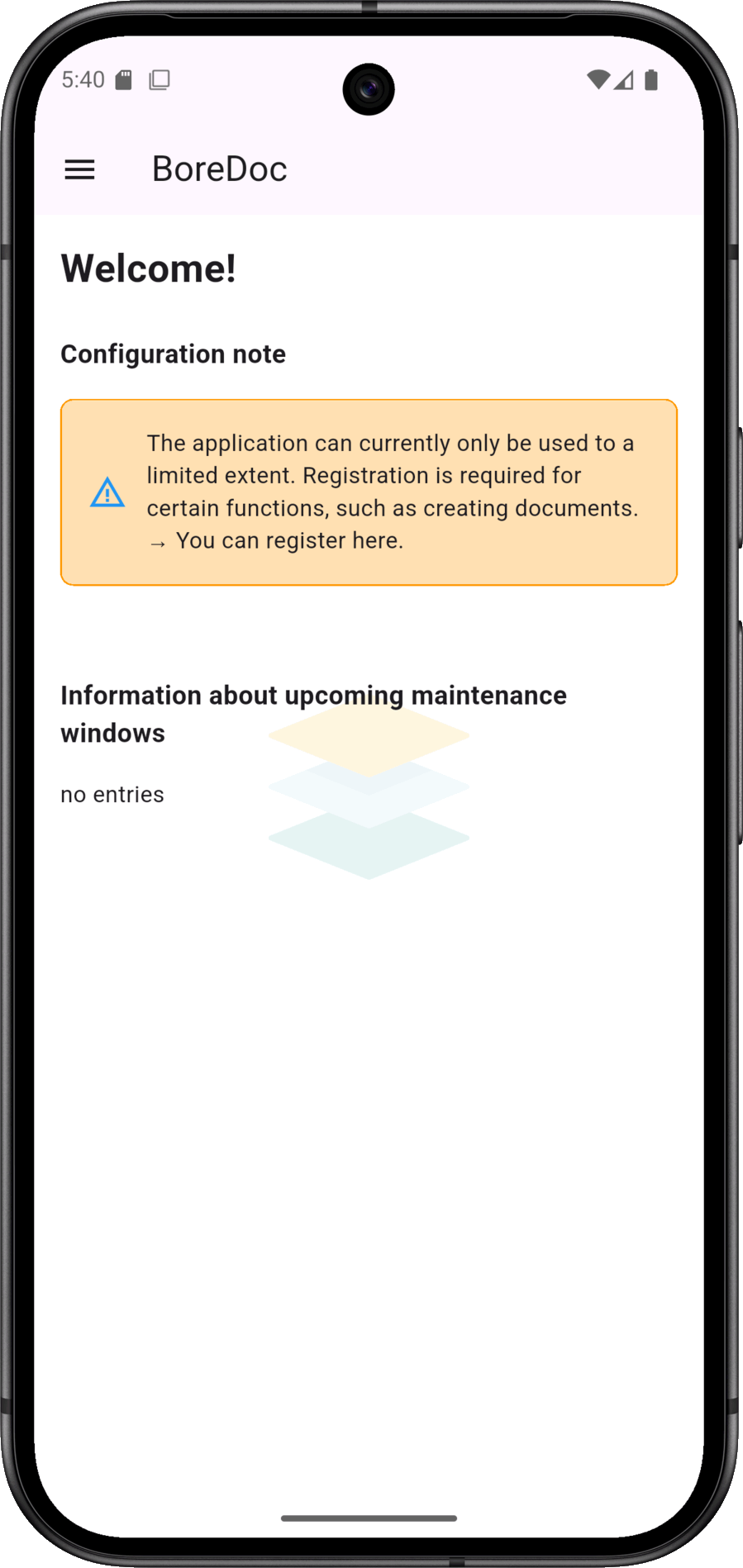
... The first step should be to register or transfer an existing registration. This is essential for creating documents.
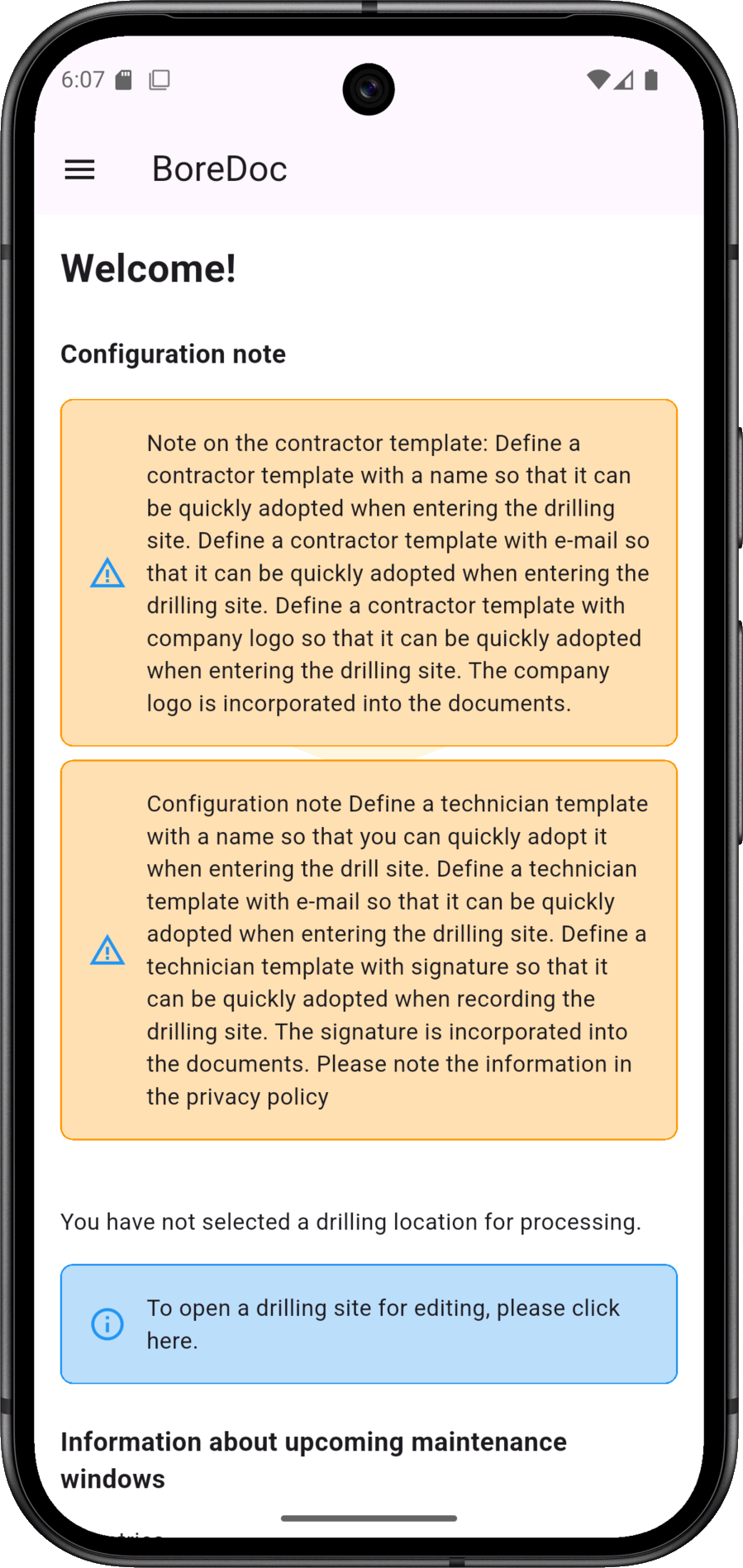
Completed templates for contractors and technicians speed up the entry of repetitive information in the input process. If the templates are not filled in, a message is displayed on the start screen.
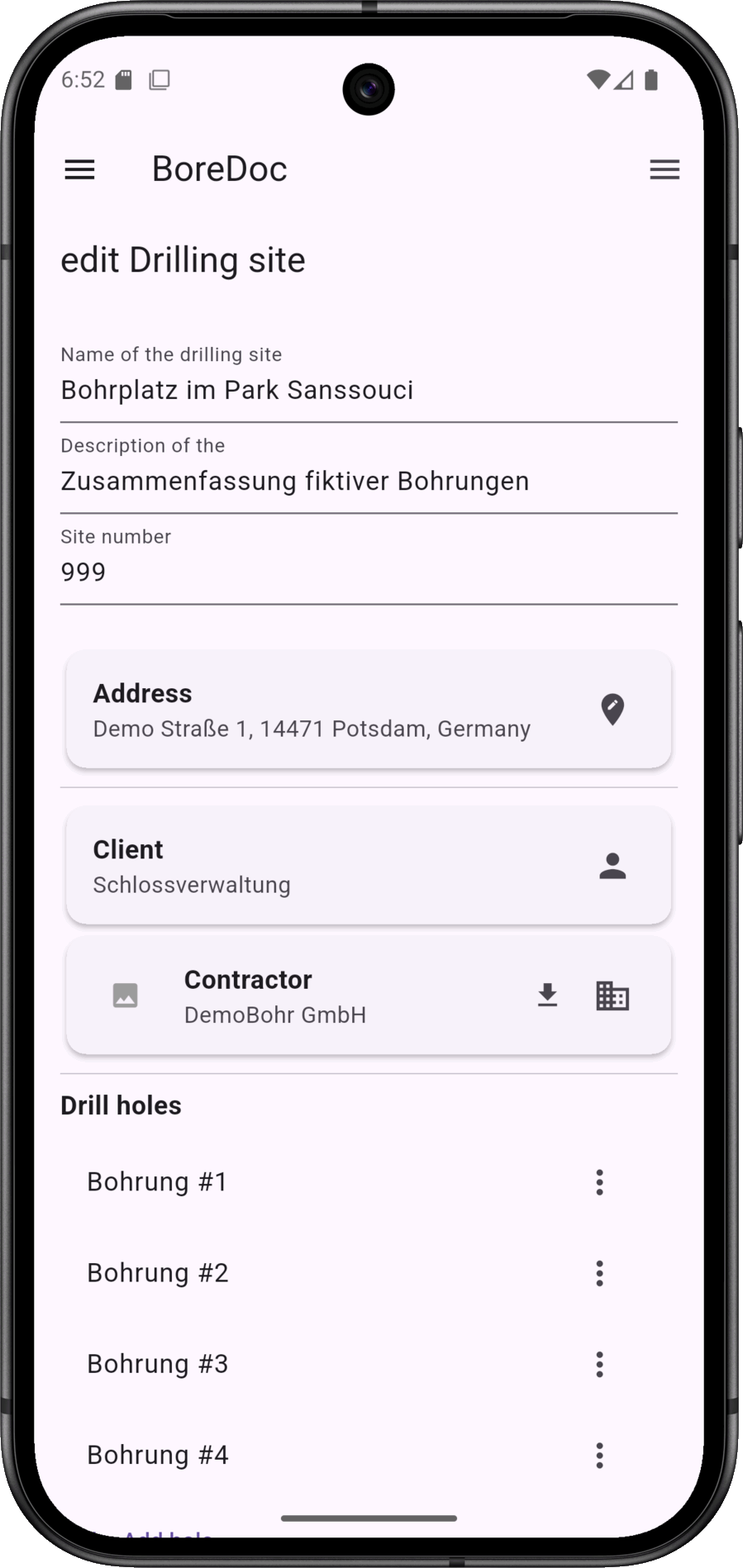
A drilling site includes master data, such as client and contractor, as well as several boreholes.
The context menu (sandwich icon top right) for the drilling site is also located here.
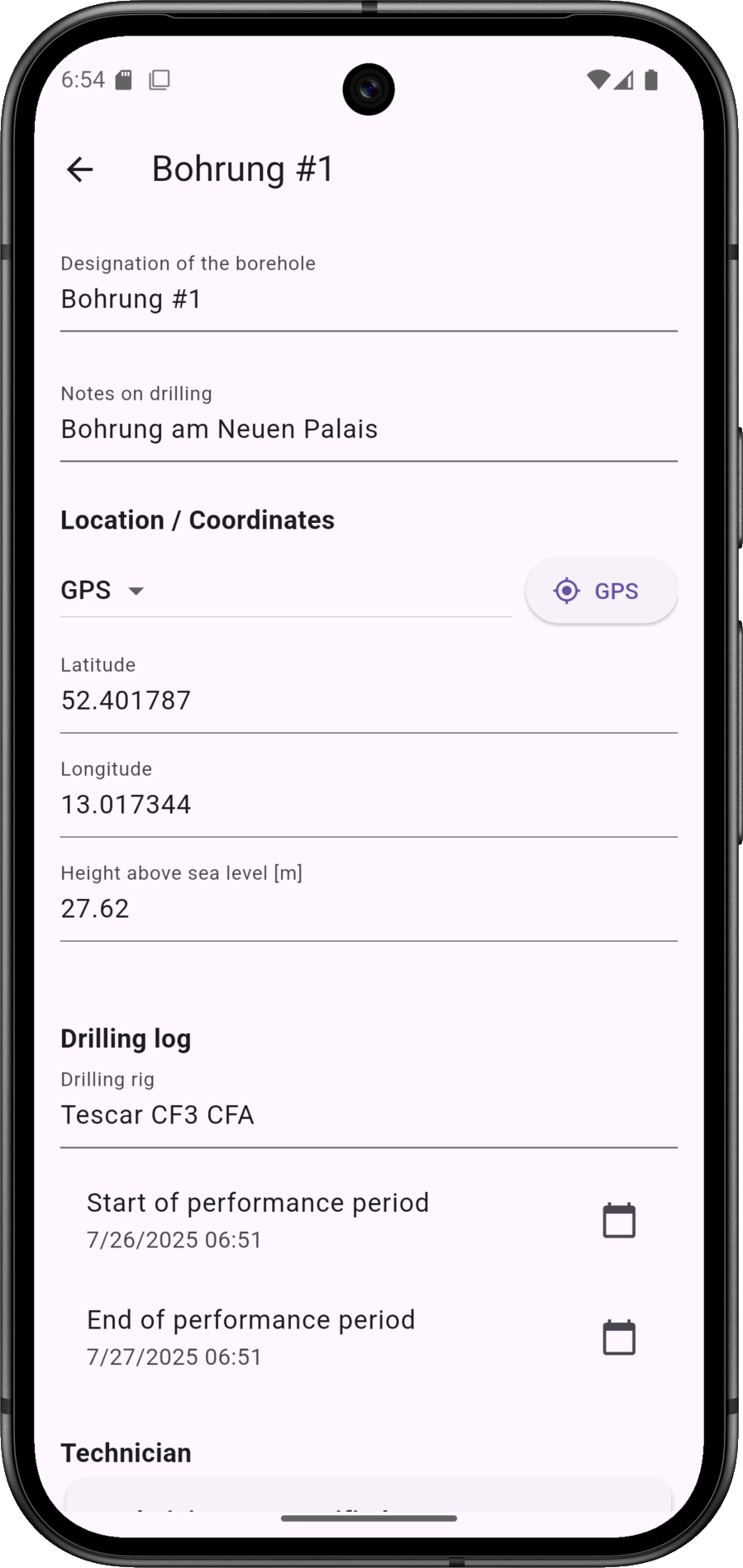
A borehole includes the usual data, such as name/designation, geo-coordinates, drilling protocol (execution period, technician, drilling sections, equipment used).
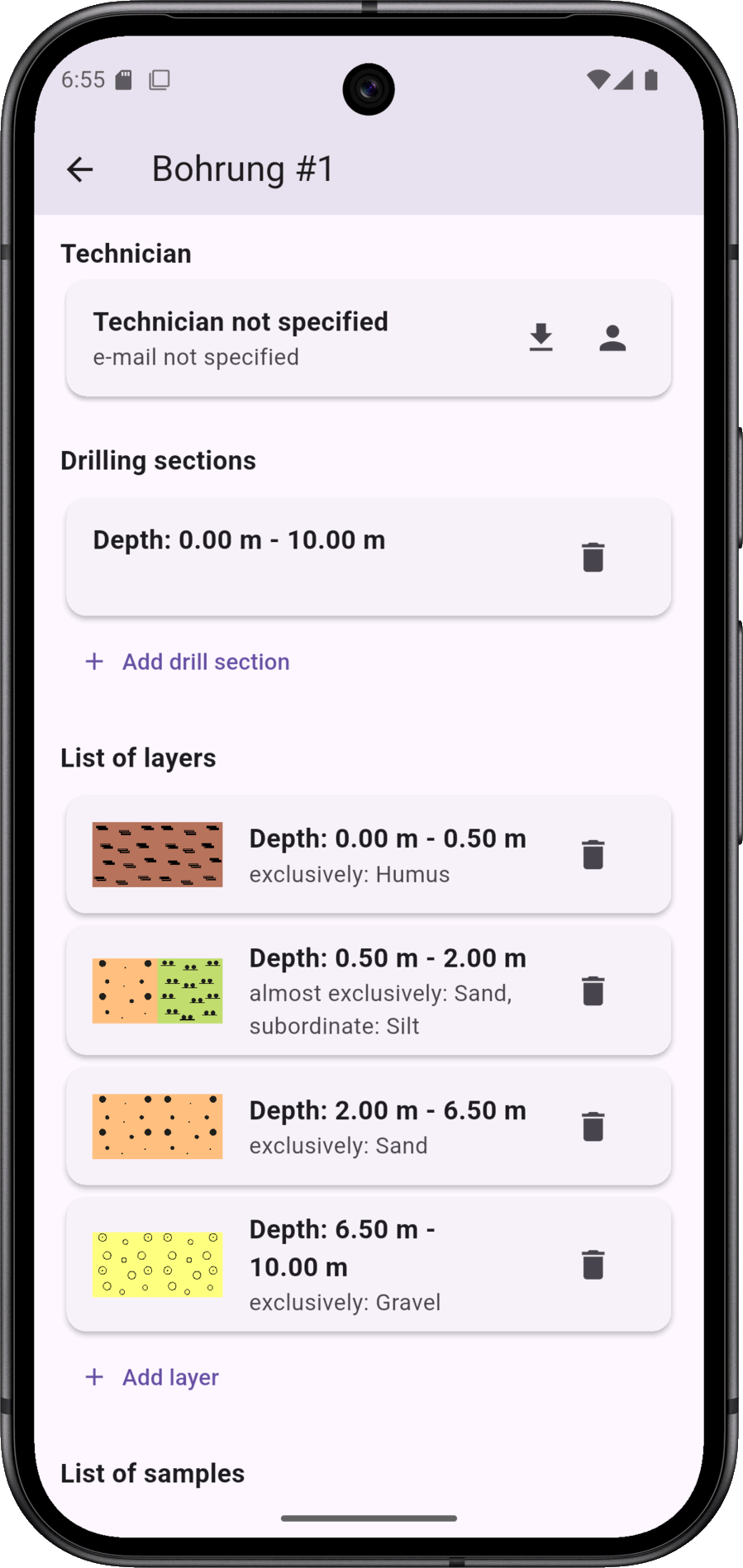
In addition, the borehole can be labelled with information on the soil layers, soil samples, water levels, backfilling and the development. Not all information is mandatory.
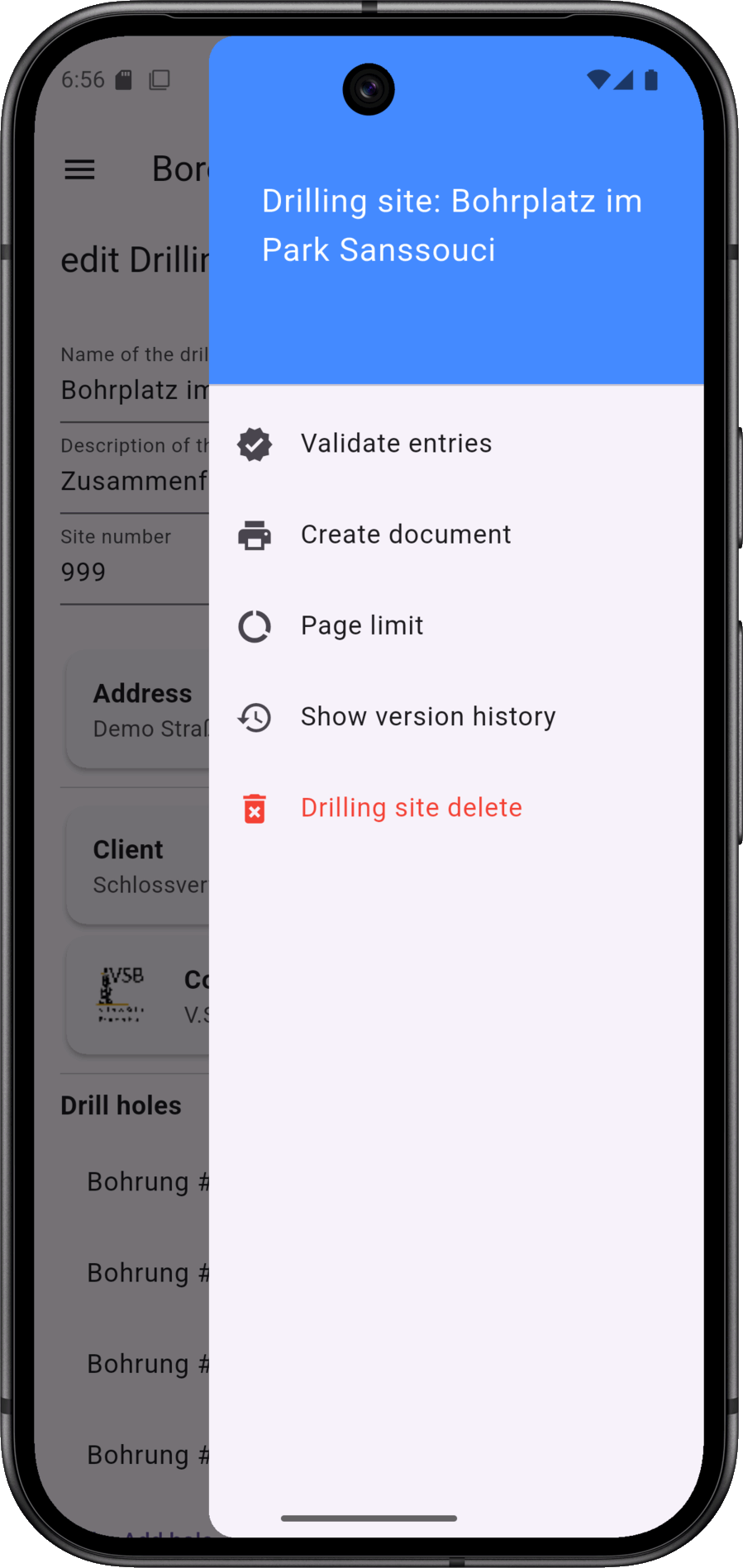
The context menu for the drilling site contains various functions, such as validating the entered data and triggering document generation.
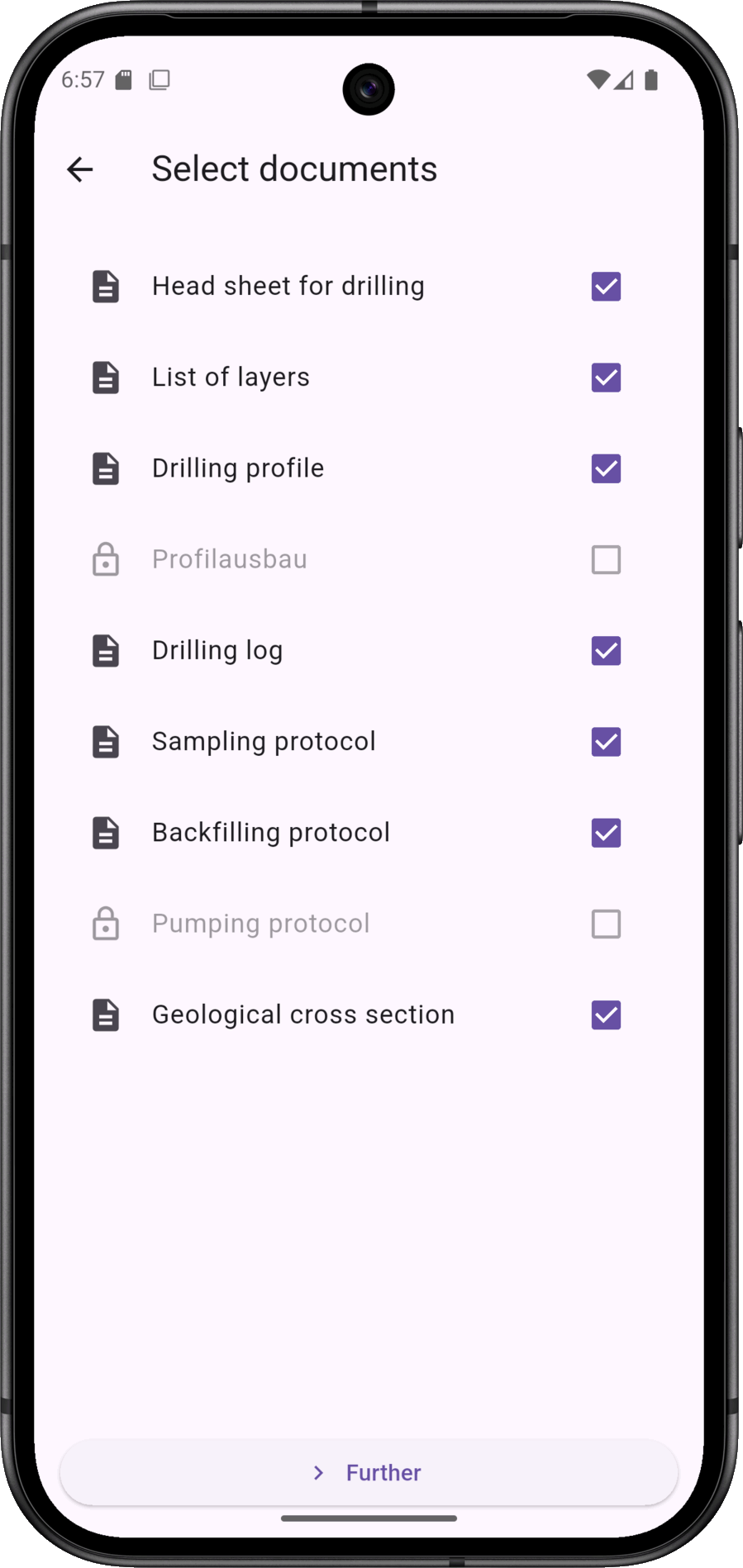
In the first step of validation, the documents to be generated are selected. These include the following: Stratigraphic log, drilling profile, drilling log, sampling log, geological section and others.
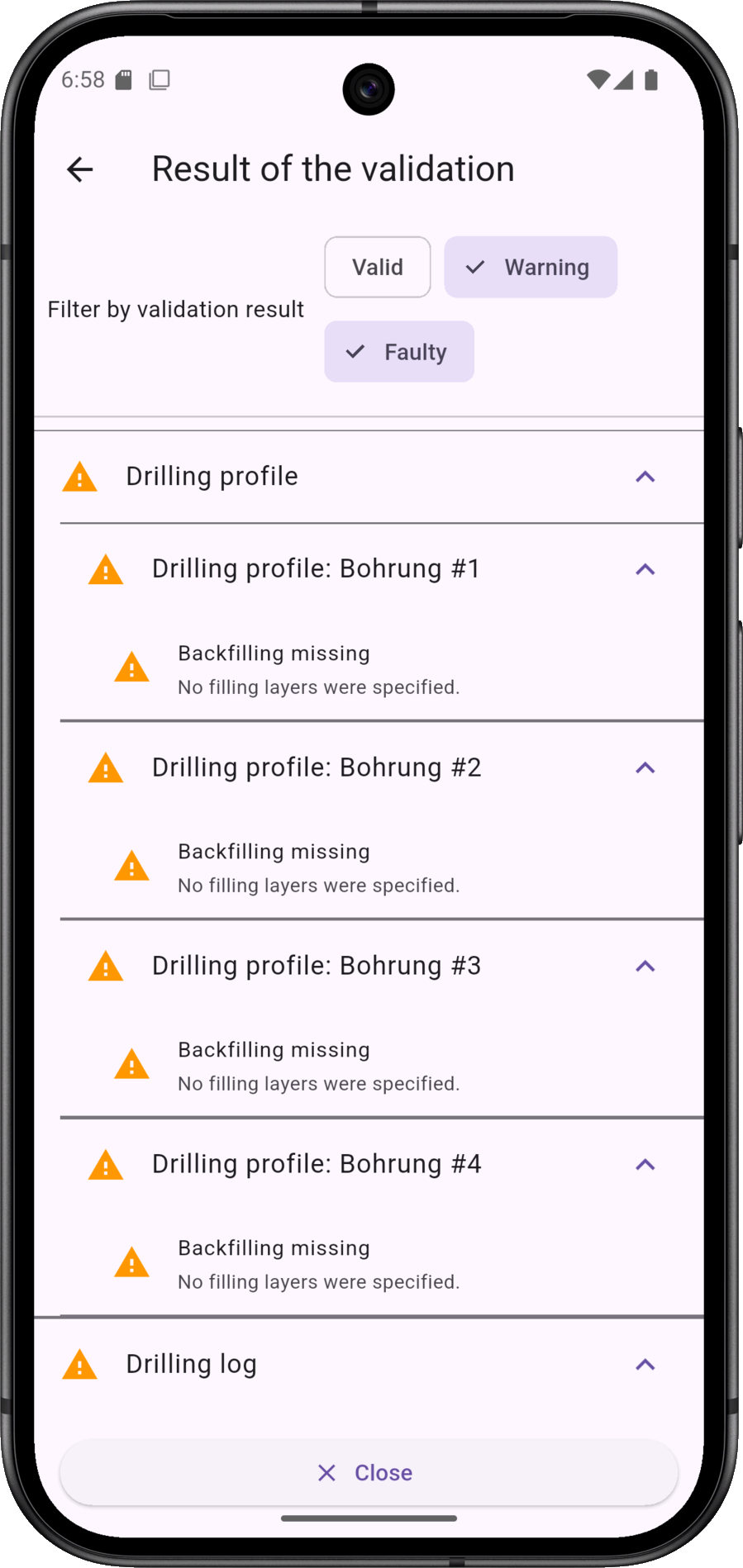
The validation result distinguishes between errors, warnings and valid. Warnings can be understood as hints. For example, it is not possible to create the extension of the borehole in the drilling profile if no information on the backfill has been provided.
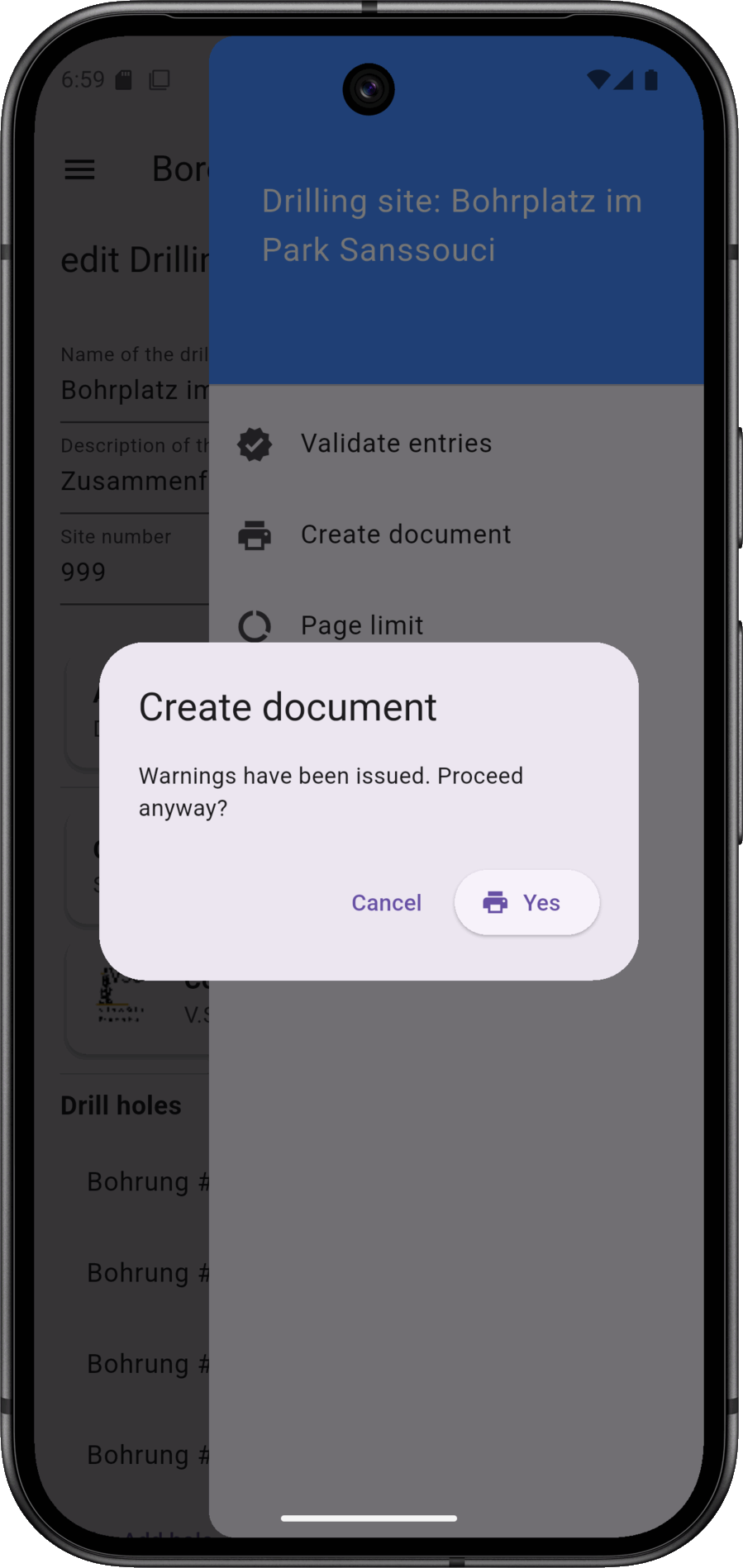
This function is available online
By requesting a document, the data from the drilling site is sent to the server and the documents are generated there. Depending on the connection speed, the process takes 5 to 20 seconds.
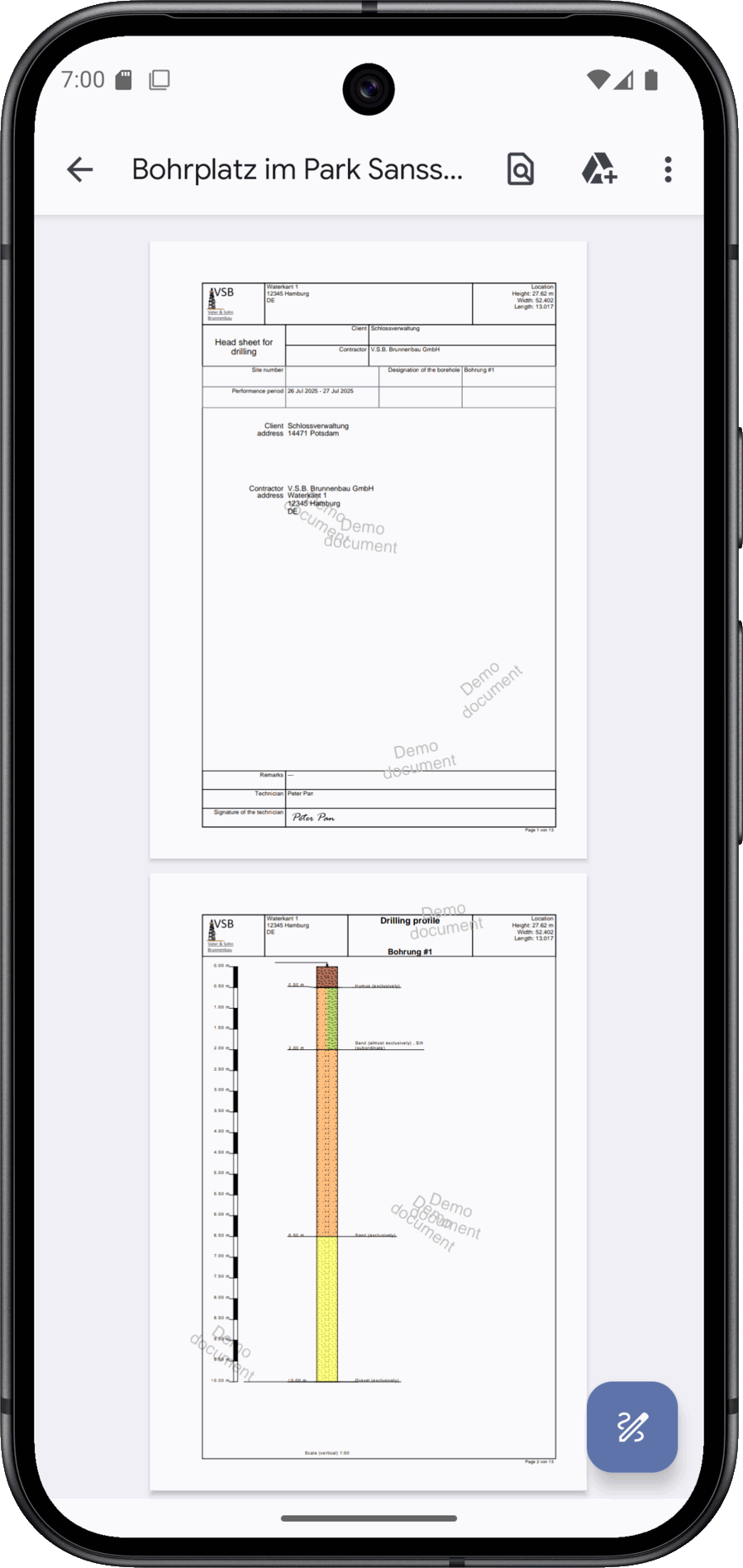
The documentation generated for the drilling site is transferred to your device as a PDF. You need a corresponding display programme to display the document.
You can currently use BoreDoc completely free of charge. Our current focus is on further developing the functions together with our users and optimising them for practical use. A binding pricing model will be introduced at a later date. Until then, you can benefit from all the advantages without restrictions and without hidden costs.

A stratigraphic log is used to systematically document geological observations during a borehole. It forms the basis for understanding the subsoil and describes which layers of earth and rock occur in which order. The aim is to create a comprehensible representation of the subsoil or geological profile, which is important for planning, construction and scientific evaluation. Both technical and geoscientific questions can be answered reliably thanks to the structured recording.
All soil types and rock layers encountered are described in detail in the layer catalogue. This includes colour, grain size, consistency, moisture or strength as well as special features such as organic inclusions or degrees of weathering. The depth information that characterises the beginning and end of the respective layer is also noted. This information enables the geological situation to be precisely assigned to the drilling depths. In this way, a continuous record is created that can later be understood by third parties without knowledge of the borehole.
A carefully compiled strata catalogue is indispensable for construction projects in which soil conditions play a central role. Engineers and geologists use it to make decisions on foundations, waterproofing or the use of materials. In addition, it has an important function in environmental investigations, as pollutant displacements or groundwater flow directions can be better assessed. It is also a valuable tool in scientific research, for example in the reconstruction of geological time periods.
The stratigraphic log thus fulfils the task of depicting complex geological relationships in a clear and standardised way. It is not only a technical document, but also a means of visualising the subsurface in a transparent and comprehensible manner. Its quality is decisive for the informative value of all further analyses based on this data.
The preparation of strata catalogues is regulated in various standards in order to ensure uniformity and comparability. DIN 4022 (soil and rock characterisation), which ensures a systematic description of strata, provides essential specifications. DIN 4023 (drilling profile) also applies, as the strata catalogue and drilling profile are closely linked in terms of content. ISO 14688, which standardises the naming and classification of soils, is also important at international level. These standards form the basis for professional and standardised documentation.
Download layer index sample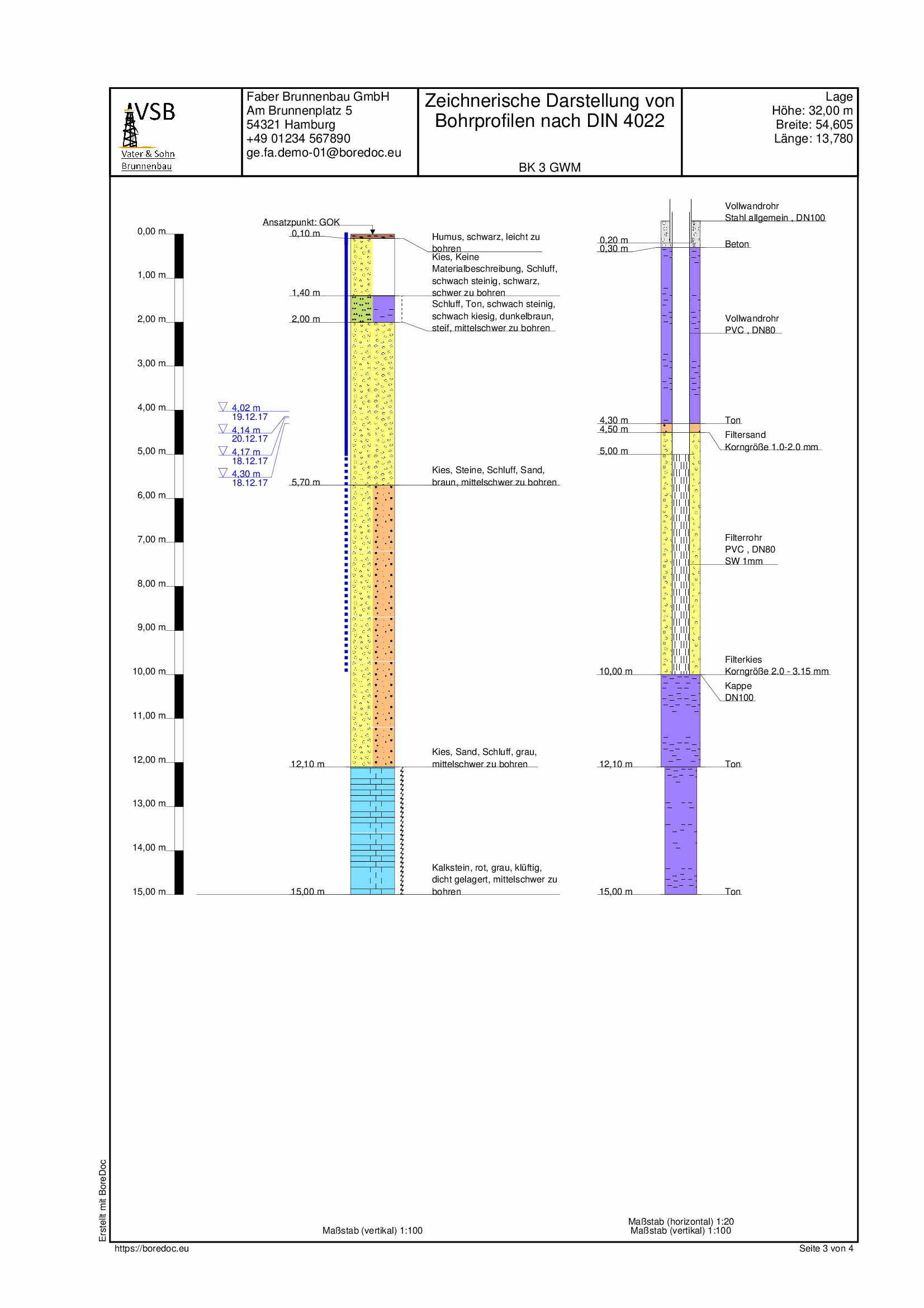
A drilling profile is the visual representation of the layer structure as determined during drilling. It is used to depict the sequence and thickness of the individual layers in a clear form. While the stratigraphic log records the properties in writing, the drilling profile offers the advantage of a quick overview. With just a few glances, experts can understand the position, extent and sequence of the layers. This makes it a central instrument in geotechnical and geological practice.
The representation is made as a vertical section along the borehole, whereby each layer is represented by a standardised symbol or colour scheme. This clear labelling ensures that soil types and rocks can be clearly distinguished from one another. Depth information supplements the visualisation and creates a direct reference to the actual drilling depth. This combination of graphic overview and metric accuracy creates a clear basis that remains comprehensible regardless of the text component.
In construction practice, the drilling profile is used to create a sound basis for planning. Engineers can use the profile to quickly decide which construction methods are suitable and where potential risks lie. It is also important in environmental protection, as it provides information on layer permeability and groundwater levels. Clients and authorities also benefit from the easy-to-understand format, which makes technical content more tangible.
The drilling profile is also valuable for geoscientific research. It documents geological deposits and helps to reconstruct the developmental history of a region. It is particularly indispensable in comparative studies of different locations because it provides objective and comprehensible data in graphical form. It thus combines the requirements of technical documentation with scientific precision.
There are binding standards for the creation of drilling profiles that ensure standardised presentation. DIN 4023 (drilling profile), which defines the graphical representation, and DIN 4022 (soil and rock characterisation) for the systematic description of the layers are decisive here. In addition, ISO 14688 is used internationally to standardise the naming and classification of soils. These specifications ensure that drilling profiles remain comparable regardless of the project or region.
Download drilling profile sample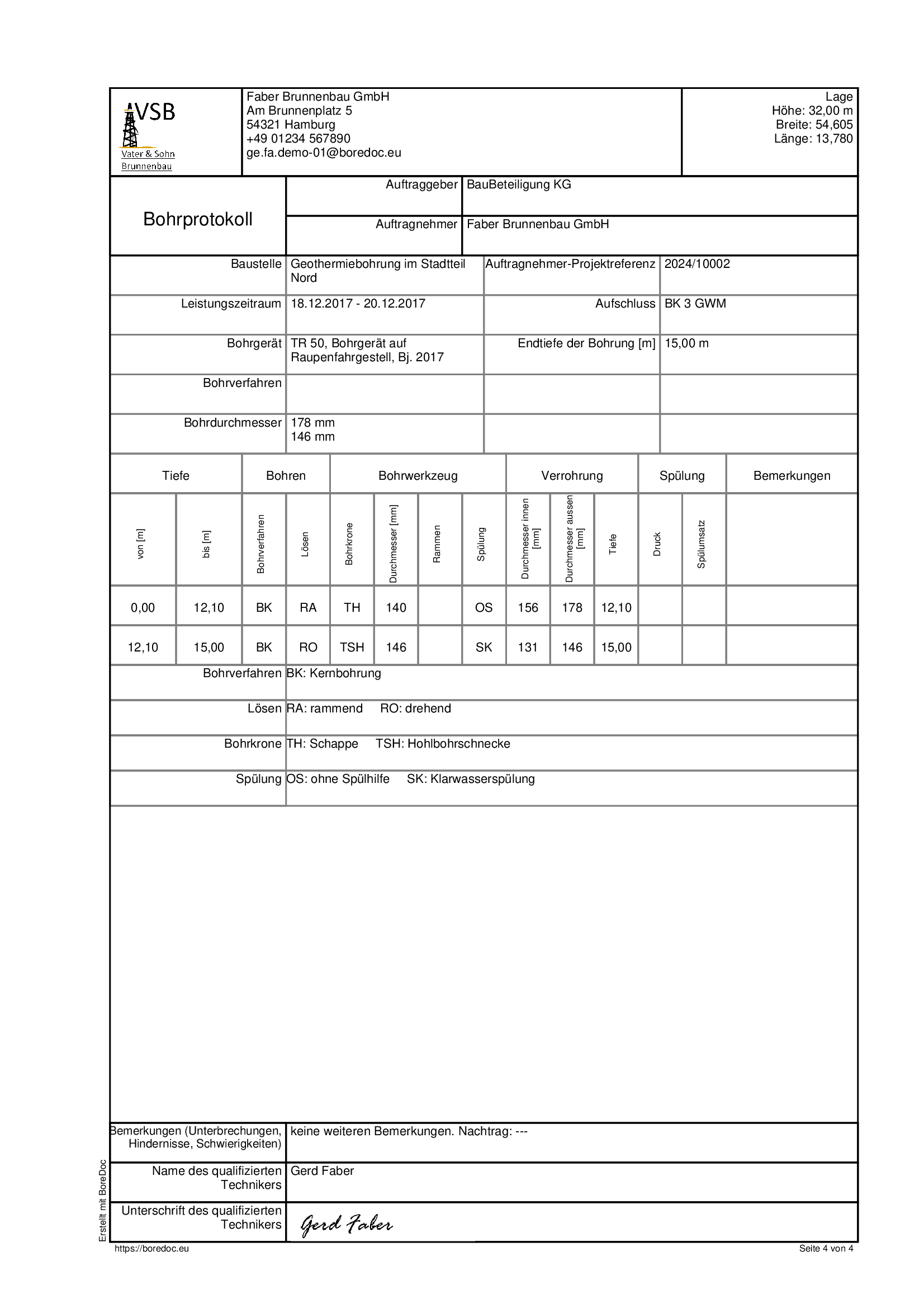
A drilling log is the written basis for all drilling documentation. It records all key steps, observations and general conditions during drilling. This enables complete traceability of the process and ensures the quality of the data collected. The aim is to make the entire process transparent and to keep it reliably accessible for technical, legal and scientific purposes.
Typically, a drilling log contains information on the drilling rig, drilling method, start and end of the work and the depth reached. In addition, aids such as pipework or flushing are documented, as are unexpected incidents or technical difficulties. All data is organised chronologically so that the drilling progress can be tracked. The log therefore not only provides information about the result, but also about the conditions under which it was achieved.
In the construction industry, the drilling log is an important tool for assessing the subsoil and evaluating risks. Engineers and clients can use the documentation to select suitable construction methods and realistically calculate costs. At the same time, it serves as proof for authorities and insurance companies that the work was carried out properly and in accordance with applicable standards. In cases of conflict, it provides a reliable basis for clarification.
The drilling log also plays an important role in geoscientific research. It not only provides data on the layers encountered, but also documents the technical conditions under which these were obtained. This improves comparability with other boreholes and makes scientific statements more meaningful. The drilling log thus combines the practice of civil engineering with the methodology of research.
The formal design of drilling logs is regulated in relevant standards. The relevant standard is DIN 4021,, which provides detailed specifications for the structure and content of drilling logs. In addition, DIN 4022 applies to the standardised addressing of soils and rocks in order to ensure uniform documentation. At international level, ISO 22475 is relevant, which contains guidelines for geotechnical explorations, sampling and groundwater measurements. These standards ensure that drilling logs are technically correct, comparable and legally robust.
Download drilling protocol sample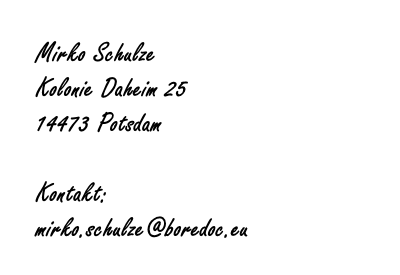
If you have any questions or suggestions regarding data protection, you are welcome to contact us via theContact formcontact us.
We take the protection of your personal data very seriously. Personal data is any data that can be used to identify you personally. This privacy policy informs you about what data we collect, how we use it and what rights you have - both when using the boredoc.eu website and when using our BoreDoc app.
When you access our website, your device automatically transmits data for technical reasons. The following data is stored separately from other data that you may transmit to us:
We store this data for the following purposes:
Your IP address is only stored for a period of 90 days.
In this case, the processing is based on our overriding legitimate interests mentioned above (Art. 6 para. 1 lit. f GDPR).
This website uses Google Analytics, a web analytics service provided by Google Ireland Ltd, Gordon House, Barrow Street, Dublin 4, Ireland.
Data collected: IP address (shortened), usage behaviour, device data
Purpose: Improvement of our offer
Legal basis: Art. 6 para. 1 lit. a GDPR (consent)
Data transfer: if necessary to third countries (e.g. USA) in accordance with EU standard contractual clauses
You can revoke your consent at any time or change it via our cookie banner.
Embedded videos from the YouTube platform (Google Ireland Ltd.) can be displayed on our website. Your IP address is transmitted to Google when loading.
Purpose: Provide multimedia content
Legal basis: Art. 6 para. 1 lit. a GDPR (consent)
Note: Depending on your cookie settings, a data connection may be established as soon as you access the page.
Our app uses Google Firebase for technical support and analysis. Firebase services used:
Processed data may include
Legal basis: Art. 6 para. 1 lit. a GDPR (consent at app start) Data processing in third countries: Google may use servers in the USA. Data is transferred in accordance with the EU's standard contractual clauses.
The BoreDoc app works offline for the most part. Only certain functions such as synchronisation, QR code sharing and creating documents use a server connection.
a) Local storage
The app saves your content (e.g. drilling data, user information) exclusively on your device, unless you explicitly activate a synchronisation or sharing function.
b) API key & e-mail
An API key is generated the first time it is used. The following data can be processed for synchronisation or team sharing:
Purpose: Access protection, collaboration, remote storage of documents
Legal basis: Art. 6 para. 1 lit. b and f GDPR
We may use external providers within the EU for hosting and API operation. These are contractually bound in accordance with Art. 28 GDPR.
Current processors:
All service providers are contractually bound in accordance with Art. 28 GDPR contractually bound.
Purpose: Access protection, collaboration, remote storage of documents
Legal basis: Art. 6 para. 1 lit. b and f GDPR
You have the right to:
Please submit enquiries via ourContact formto us.
We use the latest security measures:
We reserve the right to amend this privacy policy in order to adapt it to changed legal situations or technical developments.
The current version is available atData protectionretrievable.